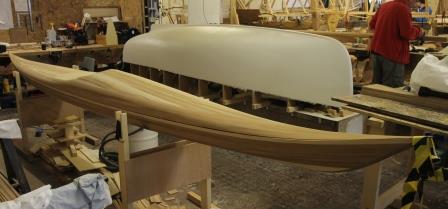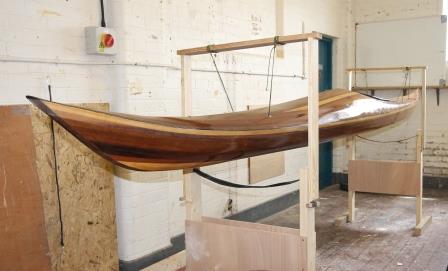Projects: Building a strip-plank kayak using WEST SYSTEM epoxy
To compliment his maritime experience, Gary Hunt wanted the chance to build a boat of his own. He joined the Boat Building Academy to start his boat building journey using WEST SYSTEM® epoxy.
Firstly, tell us a little about yourself.
My professional work has always been involved with the maritime environment, as an aviator for the Royal Navy, then in the Royal Air Force flying rotary and fixed-wing aircraft. Meanwhile I have qualified as an RYA Instructor and Examiner for sailing and am currently teaching on a school’s summer sailing programme.
I have been fortunate to sail in a variety of vessels. For example, my latest long voyage was as crew on a square-rigger from New Zealand around Cape Horn and into the South Atlantic. I also fit in sea kayak expeditions and have explored the coastline of Scotland and Southern Greenland.

How did the project come about?
To compliment my maritime education I wanted to practically learn about the skill of boat building and so started this journey by joining the Boat Building Academy.
I chose Nick Schade’s Night Heron as I liked the elegance of the design with its long flowing, sleek appearance. I also thought that a kayak with lovely curved lines would create challenges in my first-time build of a strip-plank kayak.

Choosing a strip-plank sea kayak build meant less detailed and time involvement than building a boat and therefore I had the opportunity to work on the seven other craft being built by the course. These builds included a Norlandsbåt, Skiff, Seabird Half Rater and dinghies which ranged from carvel, traditional and modern clinker, strip-planking and cold-moulded, giving us all valuable practice in their various construction methods.

Which WEST SYSTEM or PRO-SET® epoxy products did you use? How did they help?
I used WEST SYSTEM 105 Epoxy Resin® and WEST SYSTEM 205 Fast Hardener® with WEST SYSTEM® 303 special ratio Mini Pump All of the builds on the BBA course used, where required, WEST SYSTEM epoxy and products so there was commonality which meant we all received a good grounding in how to effectively use epoxy. I think the versatility of epoxy is a fantastic asset when boat building.

What was the most rewarding part of the project?
This is a hard question to answer. I really enjoyed the chance to choose the planks for their quality and colour before cutting them, then bending the strips for the curvaceous shape of hull and deck. However, the most rewarding part was wetting out the cloth and seeing the depth of colour along with the pattern design of the cedar for the first time.

What’s your top tip for boat builders looking to start a similar project?
One word: patience.
To find out more about the products used in this project visit the WSI website.
Discover more about the Boat Building Academy.




